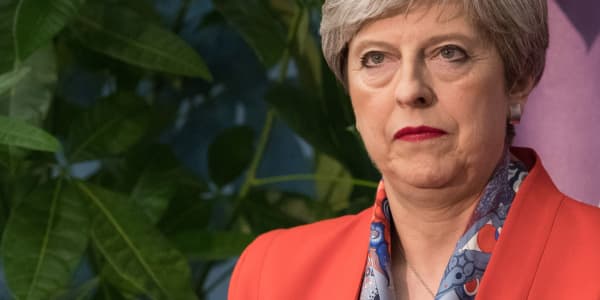After British citizens cast their ballots in the general election on Thursday, the nation woke up on Friday to discover that Theresa May's Conservative party had lost its parliamentary majority.
With the Conservatives falling short of securing over half of parliament's seats, the U.K. was dealt with a hung parliament result and division within its own nation, which could spark trouble when it comes to upcoming Brexit negotiations.
While the future of British politics hangs in the balance, Prime Minister Theresa May remained defiant on Friday, saying that she would form a government as what the "country needs more than ever is certainty".
As the election's aftermath continues to unfold, CNBC takes a look back at key moments from after the polls closed at the 2017 snap election.
Conservatives and Labour leaders secure own constituencies
As results started to roll out, it was announced that Theresa May and Opposition Leader Jeremy Corbyn had both secured their seats in their own respective constituencies, Maidenhead and Islington North.
Traders on alert
After the exit poll Thursday night pointed to a hung parliament, markets worldwide were on alert for any dramatic moves following the election outcome. British equities and moves in sterling were top of the agenda.
UK Press react to shock results
When U.K. general elections come around, it's not uncommon for many national newspapers to endorse a political party or to hold a particular view. However, many media outlets were surprised on Thursday night when the exit poll pointed to a hung parliament rather than a majority by the Conservatives. The shock outcome was felt across the nation on Friday, as well as being found on many front pages.
Journalists in wait and see mode
Journalists camp outside 10 Downing Street on Friday morning, looking for any signs of a statement from Theresa May, following the election result. Late Friday morning, it was announced the U.K. leader would be meeting with the Queen to seek permission to form a new government.
The Corbyn comeback
When the snap election was announced several weeks ago, polls suggested the Conservatives would secure an outright majority surpassing the likes of Labour and its leader Jeremy Corbyn.
However, on the morning of June 9, the picture was somewhat different. While the Labour party didn't secure an outright majority, it did see a strong rise in vote share and seats with Corbyn saying that the Labour party was ready to lead a minority government.
Cheering on the Liberal Democrats
One of the major British parties, the Liberal Democrats secured more than 10 seats in the U.K. election, with its leader Tim Farron celebrating the party's performance and his own win in his constituency, Westmorland & Lonsdale.
Its former leader Nick Clegg, however, lost his seat in Sheffield Hallam, telling an audience that there was "a parliament that is presiding over a deeply, deeply divided and polarized nation".
'The people have spoken'
Following the outcome of the U.K.'s referendum on the European Union, protests sparked nationwide. Almost one year on, protests weren't in full force on Friday morning; however, some members of the public still chose to make a statement near 10 Downing Street, with a demonstrator wearing a mask depicting the British leader.
UKIP Leader resigns
The 2015 election saw the rise in popularity of the UK Independence Party (UKIP) and its leader at the time Nigel Farage. Despite gaining only one seat in 2015, the party secured a 12.6 percent share of the national vote. Two years on, the picture was not so bright.
On Friday morning, the 2017 anti-EU party leader Paul Nuttall announced he would be stepping down with immediate effect after the party failed to secure any seats and saw its vote share drop sharply.
A meeting with the monarchy
Despite a bruising election result and facing calls to resign, the British Prime Minister sought permission from the Queen on Friday to form a new government.
Conservatives vs Scotland
One of the frontrunners in the U.K. election was that of the Scottish National Party (SNP) and its leader Nicola Sturgeon, who has been extremely vocal when it comes to Scotland's role in the Brexit negotiations.
At the 2017 election, the SNP saw some losses which called into question the possibility of a second independence referendum. On Friday, the First Minister said the party will work to forge an alliance to prevent the Conservatives from staying in power, according to Reuters.
UK leader: Will form a government to provide certainty
In spite of failing to secure an outright majority and facing calls to resign, British Prime Minister Theresa May said that her Conservative party would align itself closely with the Democratic Unionist Party from Northern Ireland, to create a government that would ensure certainty for the U.K.





